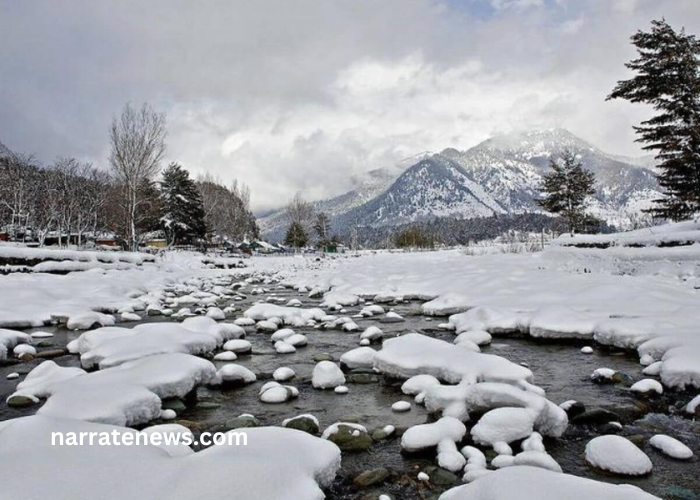
Lambasingi snowfall
Lambasingi, a quaint village nestled in the Eastern Ghats of Andhra Pradesh, India, has gained attention for its rare and captivating phenomenon—snowfall! Despite its tropical location, Lambasingi experiences occasional snowfall during the winter months, attracting visitors and researchers intrigued by this unique occurrence. This article delves into the fascinating phenomenon of Lambasingi snowfall, exploring its causes, impact on the local community, and the growing interest it has sparked among tourists.
The Enigmatic Village of Lambasingi
Lambasingi, often referred to as the “Kashmir of Andhra Pradesh,” is located in the Chintapalli Mandal of Visakhapatnam district. Situated at an altitude of approximately 1000 meters above sea level, this village enjoys a cool and pleasant climate throughout the year, unlike most other parts of coastal Andhra Pradesh. The surrounding hills and forests contribute to its unique microclimate, making it susceptible to unusually low temperatures during winter.
Understanding the Phenomenon of Snowfall in Lambasingi
The occurrence of snowfall in Lambasingi is a rare event, given its geographical location in a predominantly tropical region. The village experiences relatively cooler temperatures compared to nearby areas during winter, with temperatures dropping significantly during the peak of the season. Under specific weather conditions characterized by high humidity and low temperatures, Lambasingi witnesses frost and occasionally snowfall.
The snowfall in Lambasingi is often light and sporadic, covering the landscape in a delicate white blanket that contrasts with the typical greenery of the region. This phenomenon has become a point of fascination for locals and travelers alike, drawing curious visitors seeking a glimpse of this unexpected winter wonder.
Climatic Conditions and Geographical Factors
The unique climate of Lambasingi can be attributed to its elevation and proximity to the Eastern Ghats. The surrounding hills influence local weather patterns, resulting in cooler temperatures, especially at night. During the winter months, the combination of clear skies, calm winds, and low temperatures creates conditions conducive to frost formation and, occasionally, snowfall.
The geographical features of Lambasingi, including its altitude and the dense forest cover, contribute to the village’s distinct microclimate. The region’s topography plays a crucial role in moderating temperatures and moisture levels, making it more susceptible to sudden drops in temperature during winter.
Impact on Local Livelihoods and Tourism
The phenomenon of snowfall in Lambasingi has had a notable impact on the local community, primarily in terms of tourism and livelihoods. As word of the village’s unique climate spread, it began attracting tourists from across India who were intrigued by the prospect of experiencing snowfall in a tropical setting.
Local residents have capitalized on the influx of visitors by offering hospitality services, including homestays and guided tours. The tourism industry in Lambasingi has experienced steady growth, providing economic opportunities for villagers and promoting the preservation of local culture and traditions.
Challenges and Conservation Efforts
While snowfall in Lambasingi has brought economic benefits to the community, it has also presented challenges. The sudden increase in tourist activity has led to concerns about environmental conservation and sustainable development. Efforts are underway to strike a balance between promoting tourism and preserving the fragile ecosystem of the region.
Conservation initiatives focus on responsible tourism practices, waste management, and the protection of natural habitats. Local authorities and community organizations collaborate to raise awareness about the importance of preserving Lambasingi’s unique environment while ensuring that tourism remains a source of livelihood for residents.
Cultural Significance and Traditions
The phenomenon of snowfall holds cultural significance for the residents of Lambasingi. It is often associated with folklore and traditional beliefs, with stories passed down through generations about the magical nature of winter in the village. Snowfall has become a symbol of pride for the community, reinforcing Lambasingi’s identity as a place unlike any other in the region.
Local traditions and customs reflect the influence of the village’s climate on daily life. From culinary preferences to agricultural practices, Lambasingi’s unique weather has shaped the cultural heritage of its inhabitants, fostering a sense of resilience and adaptation in the face of nature’s unpredictability.
Future Prospects and Conservation Challenges
As interest in Lambasingi’s snowfall continues to grow, the village faces both opportunities and challenges in managing tourism sustainably. The preservation of its natural environment and the well-being of its residents are paramount concerns for policymakers and community leaders.
The future of Lambasingi hinges on striking a delicate balance between promoting tourism and safeguarding its ecological integrity. By adopting responsible tourism practices and investing in conservation efforts, Lambasingi can continue to enchant visitors while preserving its status as a rare and cherished destination.
Conclusion
Lambasingi’s snowfall phenomenon is a testament to the extraordinary diversity of India’s landscapes and climates. This remote village, nestled in the hills of Andhra Pradesh, captivates visitors with its unexpected winter magic and offers a glimpse into the resilience of its inhabitants.
As Lambasingi embraces its role as a tourist destination, it faces the dual challenge of preserving its natural heritage and supporting sustainable development. By harnessing the allure of snowfall to promote responsible tourism, Lambasingi can ensure that future generations continue to appreciate and cherish this unique corner of India.


